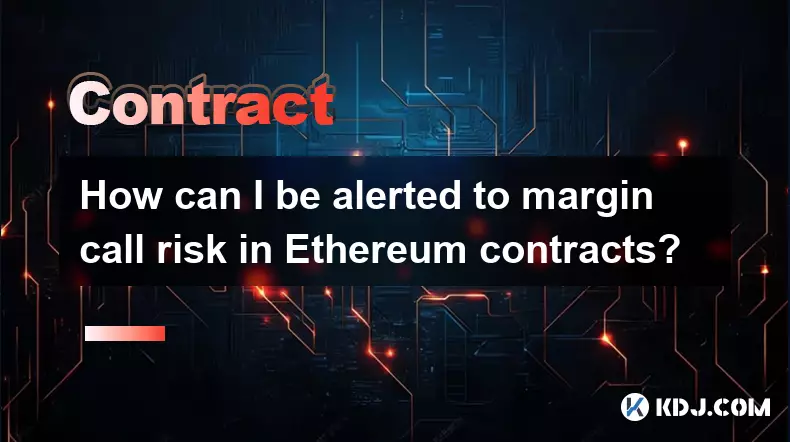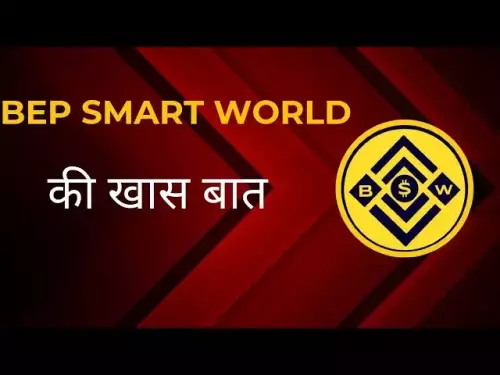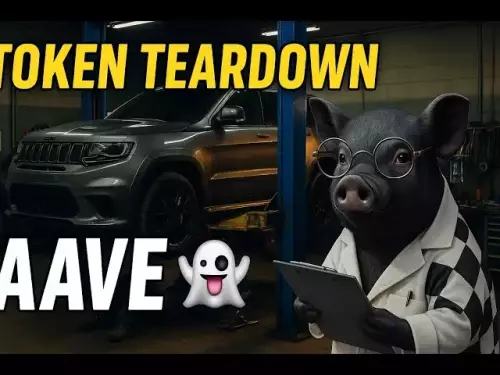-
 bitcoin
bitcoin $112195.049338 USD
2.42% -
 ethereum
ethereum $4124.915858 USD
2.81% -
 tether
tether $1.000570 USD
0.02% -
 xrp
xrp $2.861568 USD
2.25% -
 bnb
bnb $1000.346670 USD
3.04% -
 solana
solana $209.070819 USD
3.38% -
 usd-coin
usd-coin $0.999870 USD
0.02% -
 dogecoin
dogecoin $0.235379 USD
2.65% -
 tron
tron $0.335681 USD
-0.20% -
 cardano
cardano $0.803501 USD
3.38% -
 hyperliquid
hyperliquid $47.120881 USD
3.56% -
 chainlink
chainlink $21.501300 USD
3.44% -
 ethena-usde
ethena-usde $1.000571 USD
0.02% -
 avalanche
avalanche $29.793378 USD
3.62% -
 stellar
stellar $0.366964 USD
2.42%
How can I be alerted to margin call risk in Ethereum contracts?
Ethereum-based DeFi platforms use smart contracts to trigger instant liquidations when collateral values drop, making real-time monitoring via tools like DefiLlama or Chainlink critical to avoid margin calls.
Sep 28, 2025 at 11:37 pm

Understanding Margin Call Risks in Ethereum-Based Derivatives
1. Ethereum smart contracts power a growing number of decentralized finance (DeFi) platforms that offer leveraged trading and lending services. These systems often require users to post collateral, typically in ETH or stablecoins, to open leveraged positions. When the value of the collateral drops below a certain threshold due to market volatility, a margin call is triggered. Unlike traditional finance, there is no centralized broker sending alerts—users must rely on real-time monitoring tools and protocol-level notifications.
2. One major risk stems from the speed of liquidations on blockchain networks. Once a position becomes undercollateralized, bots can execute liquidations within seconds, especially during high-volatility periods. Missing early warning signs means losing a significant portion—or all—of the deposited collateral. Therefore, timely detection of margin call risks is essential for capital preservation in DeFi derivatives markets such as perpetual swaps or synthetic assets.
Tools and Services for Real-Time Monitoring
1. Several blockchain analytics platforms provide alerting mechanisms for DeFi positions. Tools like DefiLlama Alerts, Zapper Health Checks, and Rainbow Wallet Notifications allow users to track the health factor of their leveraged positions across protocols such as Aave, Synthetix, or GMX. These services monitor collateral ratios and send push or email alerts when thresholds are approached.
2. Decentralized oracle networks like Chainlink also play a role by delivering accurate price feeds to smart contracts. If an oracle reports a sharp drop in ETH’s price, the lending protocol automatically recalculates health scores. Users who integrate with dashboards that pull data from these oracles gain earlier visibility into potential margin calls.
3. Custom bot solutions built using web3.py or ethers.js can query smart contract states at regular intervals. Developers can set up scripts that check the difference between current collateral value and required minimum margin, triggering SMS or Telegram alerts when danger levels are detected.
Protocol-Level Risk Indicators and User Interfaces
1. Many DeFi applications display a “Health Factor” metric directly in their user interfaces. For example, on Aave, a health factor below 1.0 indicates immediate liquidation risk. Users should never ignore values approaching 1.5, as minor price swings could push them into unsafe territory. Monitoring this number constantly during active positions is critical.
2. Some platforms implement buffer zones or grace periods before initiating liquidation. However, these vary by protocol and are not guaranteed. Compound, for instance, uses a fixed liquidation threshold and incentive structure that leaves little room for delayed response. Interface-based warnings may appear in red or flashing indicators when thresholds are breached.
3. Wallet integrations such as MetaMask Portfolio and DeBank aggregate positions across multiple protocols. They offer unified views of exposure and can highlight which positions are nearing margin call conditions. These dashboards pull live blockchain data and refresh frequently to reflect changing market conditions.
Frequently Asked Questions
What is a health factor in DeFi lending platforms?The health factor is a numeric representation of how safe a user’s collateralized position is. It reflects the ratio of the current collateral value to the amount of debt, adjusted for asset-specific risk parameters. A value below 1.0 typically results in liquidation.
Can I receive margin call alerts via Telegram or email?Yes, several third-party services including TokenSniffer Alerts and DeFi Safety Monitor support custom alert delivery through messaging apps and email. Users must configure triggers based on wallet address and specific protocol interactions.
Do all Ethereum-based lending platforms issue margin call warnings?No formal warning system exists at the protocol level. While some front-ends show visual cues, the blockchain itself does not send notifications. Responsibility lies with the user to monitor their position using external tools or integrated dashboards.
How fast can a liquidation occur after a margin call?Liquidations can happen within one block time—approximately 12 seconds on Ethereum. High-gas-paying bots actively scan for undercollateralized positions, making response times extremely short once thresholds are crossed.
Disclaimer:info@kdj.com
The information provided is not trading advice. kdj.com does not assume any responsibility for any investments made based on the information provided in this article. Cryptocurrencies are highly volatile and it is highly recommended that you invest with caution after thorough research!
If you believe that the content used on this website infringes your copyright, please contact us immediately (info@kdj.com) and we will delete it promptly.
- Navigating Misinformation: Ensuring Safety in the Pi Network Ecosystem
- 2025-09-29 14:25:13
- XRP Price Prediction: September 29th's Crypto Comeback?
- 2025-09-29 14:25:13
- Polkadot vs. Lyno AI: Decoding the Price Forecast and AI Revolution
- 2025-09-29 14:30:01
- Trump's Brahmastra: Can Stable Coin Save the US Economy?
- 2025-09-29 14:45:17
- Pi Movement: Utility, Community, and the $314,159 Dream
- 2025-09-29 14:45:17
- Ruvi AI: Revolutionizing the Creator Economy with AI-Powered Crypto
- 2025-09-29 14:30:01
Related knowledge

How do I use the scheduled order feature in Cardano (ADA) contracts?
Sep 28,2025 at 10:18pm
Understanding Scheduled Orders in Cardano Smart ContractsCardano operates on a proof-of-stakes consensus mechanism and uses the Plutus scripting langu...

How do I enable the "scalping-only" mode for Cardano (ADA) contracts?
Sep 24,2025 at 03:19am
Understanding Scalping Strategies in Crypto Derivatives1. Scalping in cryptocurrency trading refers to executing multiple short-term trades within min...

What is the settlement time for Cardano (ADA) contracts?
Sep 28,2025 at 04:18am
Understanding Cardano's Contract Settlement Mechanism1. Cardano operates on a proof-of-stake consensus model known as Ouroboros, which fundamentally i...

How do I add margin to Cardano (ADA) contracts?
Sep 27,2025 at 07:54pm
Understanding Margin in Cardano (ADA) Smart ContractsCardano operates on a proof-of-stake blockchain that supports smart contracts through its Plutus ...

What is the maximum position limit for Cardano (ADA) contracts?
Sep 23,2025 at 11:00pm
Understanding ADA Futures and Derivatives Market Structure1. Cardano (ADA) futures contracts are offered by several major cryptocurrency derivatives e...

What is the maker fee for Cardano (ADA) contracts?
Sep 26,2025 at 09:01am
Understanding Maker Fees in Cardano (ADA) Contracts1. The concept of maker fees applies broadly across decentralized exchanges and smart contract plat...

How do I use the scheduled order feature in Cardano (ADA) contracts?
Sep 28,2025 at 10:18pm
Understanding Scheduled Orders in Cardano Smart ContractsCardano operates on a proof-of-stakes consensus mechanism and uses the Plutus scripting langu...

How do I enable the "scalping-only" mode for Cardano (ADA) contracts?
Sep 24,2025 at 03:19am
Understanding Scalping Strategies in Crypto Derivatives1. Scalping in cryptocurrency trading refers to executing multiple short-term trades within min...

What is the settlement time for Cardano (ADA) contracts?
Sep 28,2025 at 04:18am
Understanding Cardano's Contract Settlement Mechanism1. Cardano operates on a proof-of-stake consensus model known as Ouroboros, which fundamentally i...

How do I add margin to Cardano (ADA) contracts?
Sep 27,2025 at 07:54pm
Understanding Margin in Cardano (ADA) Smart ContractsCardano operates on a proof-of-stake blockchain that supports smart contracts through its Plutus ...

What is the maximum position limit for Cardano (ADA) contracts?
Sep 23,2025 at 11:00pm
Understanding ADA Futures and Derivatives Market Structure1. Cardano (ADA) futures contracts are offered by several major cryptocurrency derivatives e...

What is the maker fee for Cardano (ADA) contracts?
Sep 26,2025 at 09:01am
Understanding Maker Fees in Cardano (ADA) Contracts1. The concept of maker fees applies broadly across decentralized exchanges and smart contract plat...
See all articles










































































